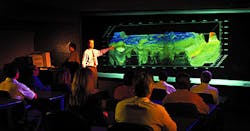Visualization facilitates large volume, complex 3D seismic interpretation
Visualization allows complex seismic interpretation problems to be solved through manipulation of 3D volume, rather than by conventional line-by-line methods. Veritas DGC Inc.'s new visualization center includes a large screen display and private workrooms with monitors.
A new visualization center in Houston allows explorationists to view and manipulate massive amounts of 3D seismic data, covering large geographic regions. Veritas DGC Inc. opened the center in December 1998.
Veritas expects prestack depth migration of nonexclusive 3D seismic data for multiple clients to be one of the main activities at the center. This computing-intensive work will thus be less expensive than if each client did prestack depth migration by itself.
Sophisticated techniques, such as prestack depth migration of 3D seismic data, are especially important for obtaining reliable images of geology in the subsalt deepwater plays in the Gulf of Mexico.
According to Dale Bowering, vice-president of business development for Veritas Marine Surveys, the center provides a "real" advantage in establishing "the big picture" in the reconnaissance stage of the exploration process.
The center houses a Silicon Graphics Onyx2 Reality Monster computer, and has a main workroom theater with an 18 by 7 ft rear-projection screen. Also, four private interpretation/visualization workrooms allow multiple teams to work simultaneously.
Veritas' Onyx2 has eight processors, 8 gigabytes of memory, 2 terabytes of storage space, and three graphics pipes.
Two Silicon Graphics Octane workstations provide additional computing power for workgroups.
A fiberoptic network connects the center to Veritas' NEC SX4 supercomputer which processes the seismic data. With the link, the data processing sequence can be periodically quality controlled from the visualization center.
Copyright 1999 Oil & Gas Journal. All Rights Reserved.
